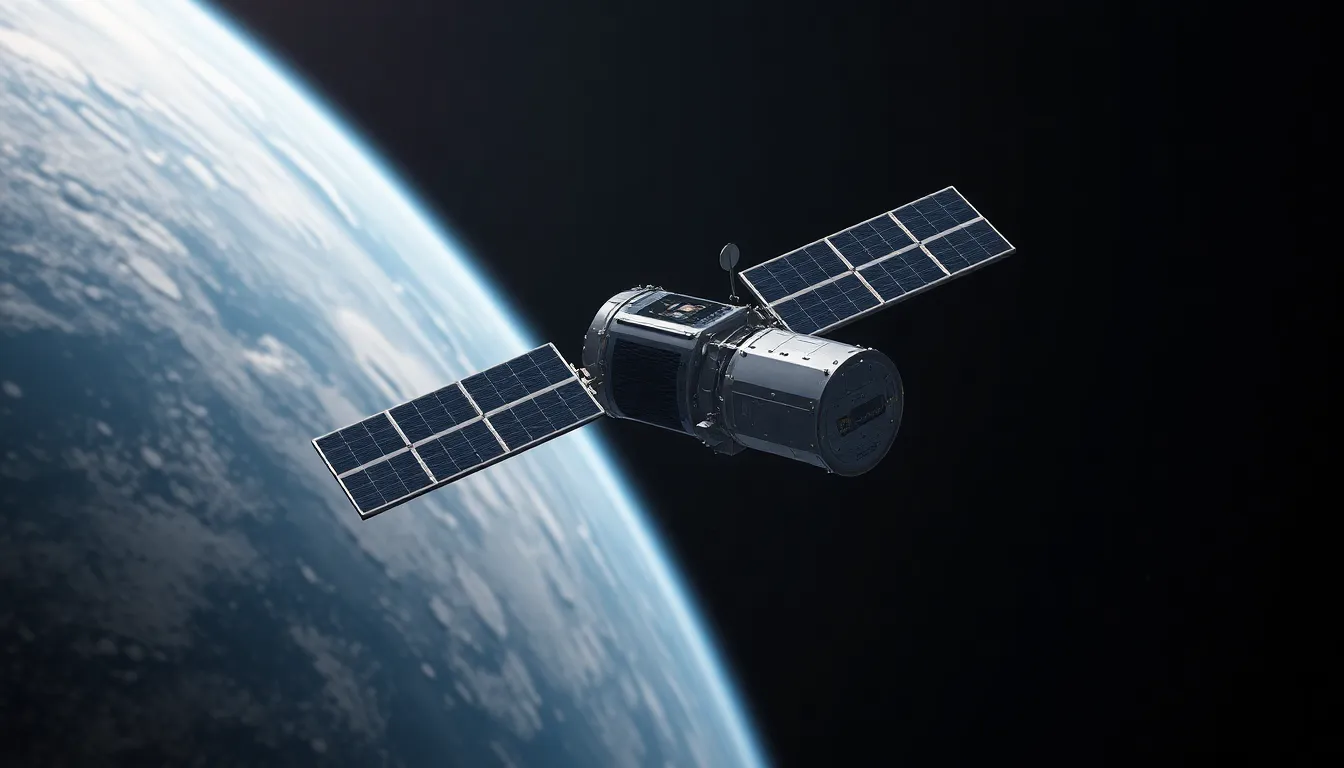Space technology isn’t just for astronauts and sci-fi enthusiasts anymore. It’s the driving force behind innovations that touch everyday life, from satellite communications to GPS navigation. Imagine a world where your morning coffee is brewed by a machine that knows exactly when to start based on the latest weather data from space. Sounds like magic, right? But it’s all thanks to the incredible advances in space tech.
Table of Contents
ToggleOverview of Space Technology Topics
Space technology encompasses diverse areas that shape modern life. Applications include satellite communications, which enable global connectivity and media broadcasting. Innovations like GPS navigation arise from advancements in satellite technology, facilitating precise location tracking for various industries.
Robotics plays a crucial role in space exploration. Rovers and automated spacecraft conduct research on distant planets and moons. These robotic systems gather data that informs scientific understanding of the solar system.
Launch technologies are pivotal for missions beyond Earth’s atmosphere. Rockets deliver satellites into orbit and carry crewed missions to the International Space Station. Advancements in reusable launch systems significantly reduce costs associated with space travel.
Data analytics is increasingly important in interpreting information gathered from space. Earth observation satellites collect data on climate change, natural disasters, and urban development. Analytical tools process this data, aiding in decision-making for governments and organizations.
Public-private partnerships drive innovation in the space sector. Companies like SpaceX and Blue Origin contribute to commercial launch capabilities and offer services for satellite deployment. Collaboration between government and private enterprises accelerates research and development.
Sustainable practices are essential alongside technological progress. Efforts to minimize space debris focus on ensuring a safe environment for future missions. Developing technologies for sustainable space exploration addresses environmental concerns.
Emerging fields like astrobiology open pathways for understanding life beyond Earth. Research focuses on extremophiles and conditions under which life might thrive on other planets. These studies inspire curiosity and drive scientific inquiry.
Exploring these topics reveals a vibrant landscape of space technology, continuously evolving to meet human needs and advance knowledge.
Satellite Technology

Satellite technology plays a crucial role in enhancing global communications and various daily applications. It allows for real-time data transmission across vast distances, significantly reshaping our interactions and navigation.
Types of Satellites
Satellites fall into several categories, each designed for specific functions. Communication satellites facilitate voice and data transmission. Earth observation satellites provide critical data for climate monitoring and natural resource management. Navigation satellites, such as those in the Global Positioning System, enable precise location tracking. Scientific satellites conduct research, delivering invaluable insights about space and Earth. Finally, military satellites support national security with surveillance capabilities. Each type contributes uniquely to the advancement of space technology and everyday life.
Applications in Communication
Communication satellites serve various vital functions across the globe. They enable television broadcasting to millions of households. Satellite phones offer connectivity in remote areas where traditional networks fail. Additionally, internet services provided via satellite support users in underserved regions. Businesses leverage satellite communication for secure data exchange and global collaboration. Enhanced connectivity fosters economic growth and enhances social interactions on a global scale, reflecting the omnipresence of satellite technology in modern life.
Space Exploration Technologies
Space exploration technologies encompass various advancements that propel humanity’s quest to understand the cosmos. Key developments in this field include the use of rovers and landers, as well as innovations in human spaceflight.
Rovers and Landers
Rovers and landers serve as critical instruments for exploring celestial bodies. NASA’s Perseverance rover, for instance, collects samples on Mars to assess past life. Equipped with sophisticated cameras, this rover captures high-resolution images of the Martian surface, providing insights into its geology. These robotic explorers gather data from challenging environments, extending our knowledge of planetary landscapes. Lunar landers, such as China’s Chang’e series, contribute to lunar research by analyzing surface samples. Each mission expands our understanding of planetary formation and evolution.
Human Spaceflight Innovations
Human spaceflight innovations focus on enhancing safety and efficiency for crewed missions. NASA’s Artemis program aims to return humans to the Moon using the Space Launch System, which boasts unprecedented lift capabilities. SpaceX’s Crew Dragon spacecraft showcases advancements in reusability, lowering mission costs. Various technologies, like life support systems, have evolved to ensure astronaut health during lengthy missions. New spacesuits designed for improved mobility protect astronauts in harsh environments, allowing for longer excursions on extraterrestrial surfaces. Both governmental and private entities contribute to groundbreaking developments, shaping the future of human space exploration.
Launch Systems and Vehicles
Launch systems and vehicles play a vital role in space exploration and satellite deployment. Advancements in this field shape how nations and private companies conduct missions beyond Earth.
Rocket Technology Developments
Rocket technology saw significant advancement in recent years. For instance, engineers introduced new propulsion systems that improve efficiency and reduce costs. Innovative materials enhance rocket durability against extreme conditions. NASA’s Space Launch System utilizes powerful engines for deep space missions, while SpaceX’s Falcon rockets incorporate cutting-edge designs for ambitious projects. These developments pave the way for more frequent and sustainable access to space.
Reusable Launch Systems
Reusable launch systems revolutionized space travel by lowering mission costs. SpaceX’s Falcon 9 features first-stage boosters that return to Earth for refurbishment and reuse. This practice reduces the expense associated with building new rockets for each launch. Companies like Blue Origin also explore horizontal landing capabilities for their New Shepard vehicle. The focus on sustainability in launch systems addresses concerns about space debris and mission efficiency. As reusable technologies progress, they promise to make space more accessible.
Space Robotics
Space robotics plays a critical role in the exploration and utilization of outer space. Robots assist in a variety of functions, increasing efficiency and safety for human missions.
Robotic Arms and Manipulators
Robotic arms and manipulators are essential tools for tasks such as satellite assembly and repair. Space agencies like NASA use these systems on the International Space Station to handle equipment and conduct experiments. With precision and versatility, these devices minimize the risk associated with human labor in space. For example, the Canadarm2, a robotic arm, enables astronauts to capture and maneuver cargo spacecraft. Their ability to operate in challenging environments makes them invaluable for both crewed and uncrewed missions.
Autonomous Spacecraft
Autonomous spacecraft enhance mission capabilities by operating independently. These vehicles perform complex tasks without constant human intervention, allowing for remote exploration of distant celestial bodies. Rovers like NASA’s Perseverance utilize advanced AI to navigate and analyze Martian terrain. These platforms make critical decisions in real-time, adapting to unexpected obstacles. Unmanned spacecraft like the Voyager probes also rely on autonomy to transmit vital data back to Earth over vast distances. Their ability to function autonomously makes space exploration more efficient and less reliant on direct control from mission control.
Emerging Trends in Space Technology
Recent advancements reveal significant trends shaping the future of space technology. Innovations like artificial intelligence and the miniaturization of devices play pivotal roles in enhancing space missions.
Artificial Intelligence in Space Missions
Artificial intelligence transforms space exploration methodologies. Rovers, such as NASA’s Perseverance, utilize AI for autonomous navigation and data analysis. Machine learning algorithms enhance satellite data processing, enabling quicker decision-making. AI also contributes to forecasting potential hazards, improving astronauts’ safety during missions. Furthermore, predictive analytics assist mission planners in optimizing resource allocation and mission timelines.
Miniaturization of Space Devices
Miniaturization revolutionizes satellite and spacecraft development. Small satellites, or CubeSats, reduce launch costs significantly while maintaining functionality. Engineers leverage innovative materials and compact designs to create lighter, more efficient payloads. Smaller devices facilitate a diversified range of missions, from Earth observation to deep space exploration. Additionally, miniaturization allows for the deployment of constellations of satellites, enhancing global communication and data collection.
Space technology is reshaping how society interacts with the universe and each other. Its advancements not only enhance daily life but also pave the way for future exploration and discovery. The integration of innovative systems and practices ensures that space missions are more efficient and sustainable.
As public and private sectors collaborate, the potential for breakthroughs in areas like AI and satellite technology continues to grow. This dynamic landscape promises to unlock new possibilities for communication, exploration, and understanding of our planet and beyond. The future of space technology is bright and full of opportunities that could redefine human existence.





